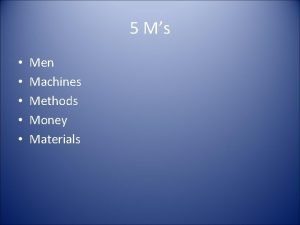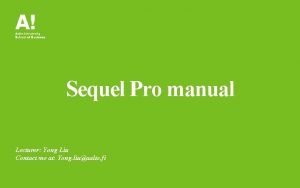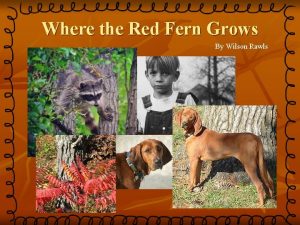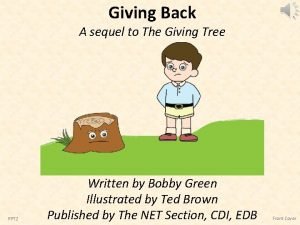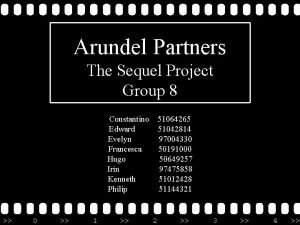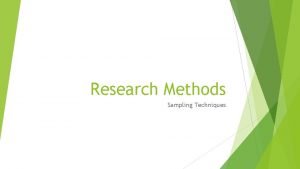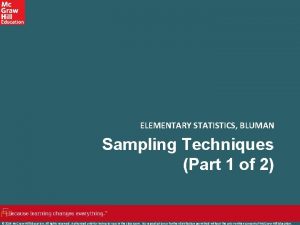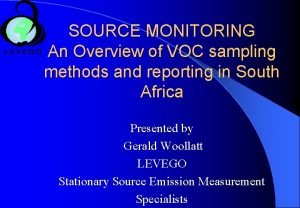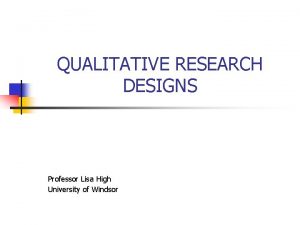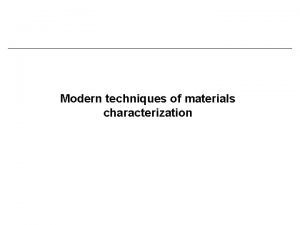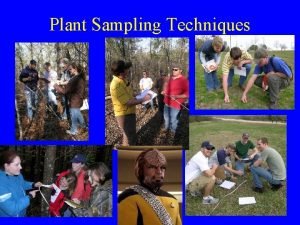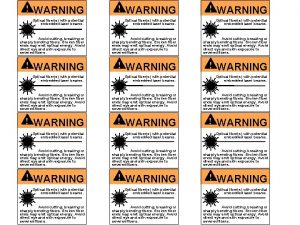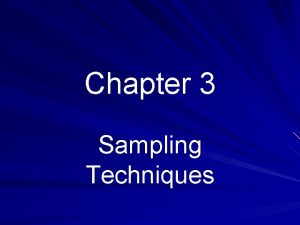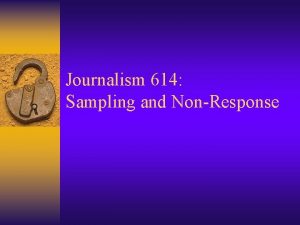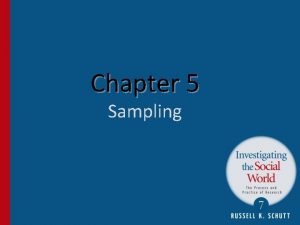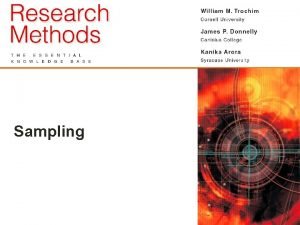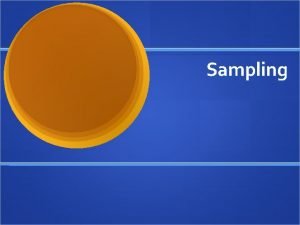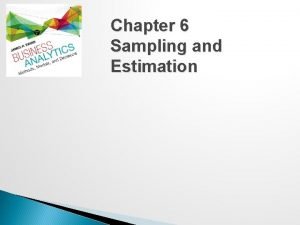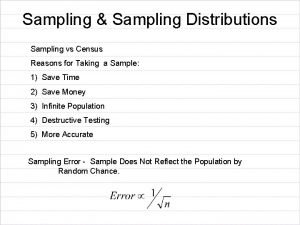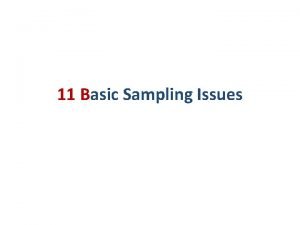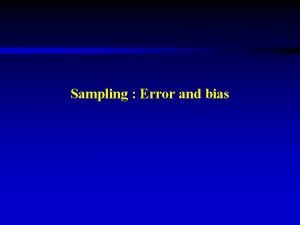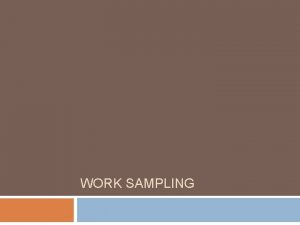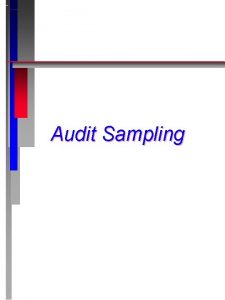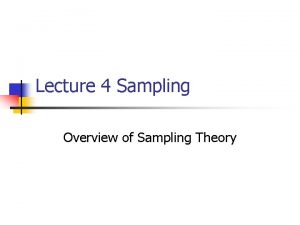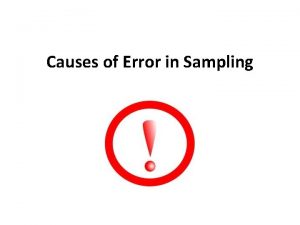Sampling Techniques THE SEQUEL Warning Material included on





























































- Slides: 61

Sampling Techniques THE SEQUEL

Warning! • Material included on Lecture Exam #1!

Importance • Which plants “important? ” • Measures importance (sp. A) – Density of A = No. inds. per unit area (reflects abundance A) – Frequency of A = No. times sp. A in samples divided by total samples taken (reflects pattern A) – Cover of A = Area occupied by A (reflects biomass A)

Methods • 1) Quadrat • 2) Belt transect • 3) Line intercept • 4) Plotless (distance) methods

Plotless (distance) methods • Based on points (0 dimensional method) • Often trees along transect

Plotless (distance) methods • • Collect: 1) tree ID 2) tree size (reflects biomass/cover) 3) distance measurement (from something to something)

Plotless (distance) methods • Method 1: Nearest individual method

Plotless (distance) methods • Method 2: Nearest neighbor method

Plotless (distance) methods • Method 3: Point centered quarter method

Plotless (distance) methods • • Information Collected: 1) tree ID 2) tree size (reflects biomass/cover) 3) distance measurement (from something to something) • IV= Rel. density + Rel. frequency + Rel. cover • <300%= <100% + < 100% • How get rel. density, rel. frequency, rel. cover values?

Plotless (distance) methods • Cover: have DBH • Convert DBH to area trunk each species

Plotless (distance) methods • Cover: have DBH • Convert DBH to area trunk each species • % rel. cover species Y: – Cover Y/Cover all species X 100% – IV= Rel. density + Rel. frequency + Rel. cover

Plotless (distance) methods • Frequency: tree identities each point • % frequency species Y: – No. pts. with species Y/Total number pts. X 100% • % rel. freq. sp. Y: – Freq. Y/Freq. all species X 100% – IV= Rel. density + Rel. frequency + Rel. cover

Plotless (distance) methods • Density: ? ? No areas measured? ? • Geometric principle: as density increases distances measured decrease – Note importance random placement points!

Plotless (distance) methods • Steps: – 1) Calc. mean distance (D) for all trees sampled – 2) Use formula: – Density (all species) = A/(correction factor)(D)2 – For metric units: – A=10, 000 m 2/hectare (ha) – D in meters (m) • Correction factor?

Plotless (distance) methods • Steps: • Correction factor? – 2 nearest individual method – 1. 67 nearest neighbor method – 1 point centered quarter method

Plotless (distance) methods • Steps: • Correction factor? – 2 for nearest individual method – 1. 67 for nearest neighbor method – 1 for point centered quarter method • 3) Calc. density species Y: – No. Y/No. all species X Density (all species) • 4) % rel. density Y: – Density Y/Density all species X 100%

Plotless (distance) methods • IV species Y • IV= Rel. density + Rel. frequency + Rel. cover • <300%= <100% + < 100% • Repeat calcs. other species

Plotless (distance) methods • Point Centered Quarter method: – 1) More data/point – 2) Relatively simple – 3) No correction factor in density formula (correction factor = 1)

How place sample units? • Generally, random best • Define? • All potential samples have equal chance inclusion • Why best? – Eliminate bias – May be required: statistics/equations (e. g. , density formula for plotless methods)

How place sample units? • Random not same as: • Arbitrary: Attempt eliminate conscious bias • Systematic: Use numeric pattern (ex, every 5 th tree) • Deliberate: Choose with criteria (ex, all trees > 30 cm dbh)

How place sample units? • Random not always representative sample • Ex: X X X

How place sample units? • Techniques: • Random • vs. • Stratified random (subdivide area & sample randomly in each division)

How place sample units? • Techniques: • Systematic

How place sample units? • Techniques: • Random-Systematic (start random, place points systematically: or vice versa) systematic random OR

Ch. 4: Soils, Nutrition etc.

• Definition: Soil – Natural body: layers (horizons)

• Definition: Soil – Natural body: layers (horizons) – Mineral + organic matter (OM) – Differs from parent material: substance from which soil derived

Weathering Factors • Mineral component: generated by weathering rock

Soil Texture • Major particle sizes (know these) know these B: clays A: Sand & silt

Textural triangle • Distribution particles by size class: texture • Loam: mix sand, silt, clay • Texture important: fertility, water availability

Soil Structure • Particles form peds • Affect water + root penetration How important? ?

Organic matter (OM) • Humus: partly decomposed OM • Negatively charged: – carboxyl groups (-COOH) – phenols

Soil Horizons

Soil Horizons • Vertical gradients – Leaching: wash material upper to lower layers – Weathering: great at surface – Biotic effects: great at surface

Soil Horizons • Major horizons: • O: organic matter (surface) • A: surface soil. High organic matter • E: leaching strong

Soil Horizons • Major horizons: • B: subsurface soil. – Deposition – Chemical changes (secondary minerals/clays)

• • • Soil Horizons Major horizons: B: subsurface soil. Hardpan: cemented soil grains Claypan: dense clay Both: interfere water penetration, roots • Humic layer: organic matter from E

Soil Horizons • Major horizons: • C: weathered parent material • R: unweathered parent material

Soil Horizons • Layers subdivided (numbers) Fig. 4. 5

Organisms • Plants influence soil & vice versa • How? • 1) Roots – Depth: record 394 ft: fig tree (Echo Caves, South Africa) – Amount (biomass/unit volume/yr) – Size: woody (shrub/tree) vs. fibrous (grasses)

Organisms • How plants influence soil? • 2) Base cycling • Nutrients “in play”

Organisms • Fertile island effect: under desert shrubs soil fertile • Ex, creosote bush: under shrubs--more nutrients

Organisms • How plants influence soil? • 3) Litter acidity • Ex: soils under spruce (conifer) vs hardwood

• • Parent Material Within climate, parent material major influence Ex, serpentine soil High Mg, low Ca Lots Ni, Cr

Parent Material • Extreme cases, serpentine “barrens”

• • Parent Material Within climate, parent material major influence Ex, granite outcrop soil Forest on granite Lots sand (coarse texture) in Australia Soil dry (water drains)

Time • General trends (as time increases): – – p. H decreases organic matter increases clay increases depth increases

Soil Fertility • Defn. : Ability soil hold & deliver nutrients • Determined by texture, organic matter, p. H Holding soil….

• Texture: clays Soil Fertility – Negative charge: hold useful cations (Ca++, K+, Mg++, Zn++) • Huge surface

Soil Fertility • Humus negative charge: clay & humus hold cations

Soil Fertility • Cation Exchange Capacity: amount negative charge/unit soil • Units: centimoles charge/kg dry soil (cmolc/kg) • Represents “potential fertility”

Soil Fertility • Exs: • US prairie: 30 cmolc/kg • NE US conifer forest: 2 cmolc/kg

Soil Fertility • H+ (& Al+++) also attracted negative charge. – Not useful. • Base saturation (BS): % sites “good” cations (bases: Ca++, Mg++, K+) plus Na+

Soil Fertility • BS, p. H & CEC determine “actual fertility” – 1) High CEC + high BS = more fertile – 2) If BS low: p. H low (lots H+) Actual fertility: Multiply BS by CEC

Soil p. H • Most AL: 4. 5 -5. 1 (strongly acid) • Black Belt: 7. 9 -8. 4 (alkaline)

Soil p. H • p. H effects: • 1) H+ damages roots (@ extreme p. H values) • 2) soil microflora – Acid favors fungi (incl. mycorrhizae) – Alkaline favors bacteria • 3) soil structure (sometimes)

Soil p. H • 4) nutrient availability. Major influence! • Nutrient deficiency: • Acid: N, P, Ca, Mg, K, S

Soil p. H • 4) nutrient availability. Major influence! • Nutrient deficiency: • Acid: N, P, Ca, Mg, K, S • Alkaline: Fe, Mn, Zn, Cu, Co, B

• 4) nutrient availability. Major influence! • Nutrient toxicity: • Acid: Fe, Mn, Zn, Cu, Co • Alkaline: Mo Soil p. H

• Plant sensitivity & nutrient needs • Black Belt lab (#2): – Black Belt soil: Soil p. H
 Men money material and machines are included in
Men money material and machines are included in The book thief sequel
The book thief sequel Yong liu aalto
Yong liu aalto Redbone coonhound where the red fern grows
Redbone coonhound where the red fern grows The giving tree ppt
The giving tree ppt What is a sequil
What is a sequil Arundel partners the sequel project case solution
Arundel partners the sequel project case solution A consumer confidence researcher asks several retailers
A consumer confidence researcher asks several retailers Objective of sampling
Objective of sampling Stratified random sample vs cluster sample
Stratified random sample vs cluster sample Contoh event sampling dalam observasi
Contoh event sampling dalam observasi Cluster sampling vs stratified sampling
Cluster sampling vs stratified sampling Quota random sampling technique
Quota random sampling technique Natural sampling vs flat top sampling
Natural sampling vs flat top sampling What is purposive sampling in qualitative research
What is purposive sampling in qualitative research Types of sampling psychology
Types of sampling psychology Sampling techniques
Sampling techniques Sampling techniques
Sampling techniques Sampling techniques
Sampling techniques Sampling techniques in qualitative research
Sampling techniques in qualitative research Geometric symbols in engineering drawing
Geometric symbols in engineering drawing Standard costing formula
Standard costing formula Material culture and nonmaterial culture
Material culture and nonmaterial culture Refers to the knowledge language values customs
Refers to the knowledge language values customs All groups create norms to enforce their cultural values.
All groups create norms to enforce their cultural values. Examples of materials that are useful and harmful
Examples of materials that are useful and harmful Classification of material characterization techniques
Classification of material characterization techniques Fonctions techniques et solutions techniques
Fonctions techniques et solutions techniques Hình ảnh bộ gõ cơ thể búng tay
Hình ảnh bộ gõ cơ thể búng tay Frameset trong html5
Frameset trong html5 Bổ thể
Bổ thể Tỉ lệ cơ thể trẻ em
Tỉ lệ cơ thể trẻ em Voi kéo gỗ như thế nào
Voi kéo gỗ như thế nào Chụp phim tư thế worms-breton
Chụp phim tư thế worms-breton Chúa yêu trần thế alleluia
Chúa yêu trần thế alleluia Kể tên các môn thể thao
Kể tên các môn thể thao Thế nào là hệ số cao nhất
Thế nào là hệ số cao nhất Các châu lục và đại dương trên thế giới
Các châu lục và đại dương trên thế giới Công thức tính thế năng
Công thức tính thế năng Trời xanh đây là của chúng ta thể thơ
Trời xanh đây là của chúng ta thể thơ Mật thư anh em như thể tay chân
Mật thư anh em như thể tay chân 101012 bằng
101012 bằng Phản ứng thế ankan
Phản ứng thế ankan Các châu lục và đại dương trên thế giới
Các châu lục và đại dương trên thế giới Thơ thất ngôn tứ tuyệt đường luật
Thơ thất ngôn tứ tuyệt đường luật Quá trình desamine hóa có thể tạo ra
Quá trình desamine hóa có thể tạo ra Một số thể thơ truyền thống
Một số thể thơ truyền thống Cái miệng xinh xinh thế chỉ nói điều hay thôi
Cái miệng xinh xinh thế chỉ nói điều hay thôi Vẽ hình chiếu vuông góc của vật thể sau
Vẽ hình chiếu vuông góc của vật thể sau Biện pháp chống mỏi cơ
Biện pháp chống mỏi cơ đặc điểm cơ thể của người tối cổ
đặc điểm cơ thể của người tối cổ Thế nào là giọng cùng tên?
Thế nào là giọng cùng tên? Vẽ hình chiếu đứng bằng cạnh của vật thể
Vẽ hình chiếu đứng bằng cạnh của vật thể Fecboak
Fecboak Thẻ vin
Thẻ vin đại từ thay thế
đại từ thay thế điện thế nghỉ
điện thế nghỉ Tư thế ngồi viết
Tư thế ngồi viết Diễn thế sinh thái là
Diễn thế sinh thái là Dạng đột biến một nhiễm là
Dạng đột biến một nhiễm là Các số nguyên tố là gì
Các số nguyên tố là gì Tư thế ngồi viết
Tư thế ngồi viết
